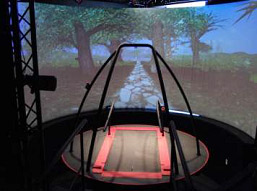Advanced Platform Technology Center
Virtual Reality Human Performance Laboratory (VGait)
 The Virtual Reality Human Performance Laboratory is dedicated to improve the lives of veterans with mobility challenges due to neurological, orthopedic and musculoskeletal disorders. We are located in the Louis Stokes Cleveland Department of Veterans Affairs Medical Center (LSCDVAMC) and are under the direction of Dr. Ronald Triolo. Our staff consists of scientists, clinicians and engineers who seek to aid those living with limb loss, spinal cord injury, vestibular disorders, the after effects of stroke and traumatic brain injury, and other injuries or pathologies that hamper mobility. The laboratory houses a V-Gait virtual reality system that employs interactive, real-time visual and auditory feedback for evaluation, training and rehabilitation. The system includes an instrumented dual-belt treadmill with a virtual environment which is synchronized to our 10 camera motion capture system and three video cameras. We can also link our system with surface electromyography and segmental inertial measurements. Our staff uses this system to analyze the mechanics of gait, standing balance, and wheelchair mobility. We aim to improve dynamic balance, refine mobility and compensation strategies, and improve collision avoidance in a safe and assuring environment, supplementing real world experiences. To this end, our equipment measures and displays biomechanical parameters in real-time, including stride length, step width, step frequency, symmetry, joint kinematics and kinetics. This real-time capability enables adjustments, analysis and training in the same session. We also have a wide variety of tailored treatment and assessment virtual reality protocols which can use stimulating games/coaching. In addition to our wireless surface electromyography, accelerometers, and inertial sensors, we have a suite of user friendly building blocks for low cost USB sensing and control. Our clinical collaborators include the LSCDVAMC Departments of Neurology, Physical Medicine and Rehabilitation, and Prosthetics and Orthotics.
The Virtual Reality Human Performance Laboratory is dedicated to improve the lives of veterans with mobility challenges due to neurological, orthopedic and musculoskeletal disorders. We are located in the Louis Stokes Cleveland Department of Veterans Affairs Medical Center (LSCDVAMC) and are under the direction of Dr. Ronald Triolo. Our staff consists of scientists, clinicians and engineers who seek to aid those living with limb loss, spinal cord injury, vestibular disorders, the after effects of stroke and traumatic brain injury, and other injuries or pathologies that hamper mobility. The laboratory houses a V-Gait virtual reality system that employs interactive, real-time visual and auditory feedback for evaluation, training and rehabilitation. The system includes an instrumented dual-belt treadmill with a virtual environment which is synchronized to our 10 camera motion capture system and three video cameras. We can also link our system with surface electromyography and segmental inertial measurements. Our staff uses this system to analyze the mechanics of gait, standing balance, and wheelchair mobility. We aim to improve dynamic balance, refine mobility and compensation strategies, and improve collision avoidance in a safe and assuring environment, supplementing real world experiences. To this end, our equipment measures and displays biomechanical parameters in real-time, including stride length, step width, step frequency, symmetry, joint kinematics and kinetics. This real-time capability enables adjustments, analysis and training in the same session. We also have a wide variety of tailored treatment and assessment virtual reality protocols which can use stimulating games/coaching. In addition to our wireless surface electromyography, accelerometers, and inertial sensors, we have a suite of user friendly building blocks for low cost USB sensing and control. Our clinical collaborators include the LSCDVAMC Departments of Neurology, Physical Medicine and Rehabilitation, and Prosthetics and Orthotics.
Photo: CARE/DETECT and the Caren System Equipment




















